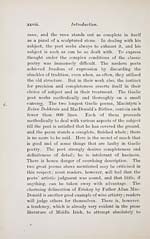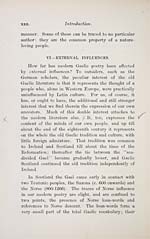Download files
Complete book:
Individual page:
Thumbnail gallery: Grid view | List view

Introduction. xxix;
exhaust the details of a description by piling up a.
succession of descriptive adjectives. In English it has.
been tried by Southey in his description of the cataract
of Lodore. In Gaelic it was a well recognised form,
and it should not be condemned too hastily. The test
is whether the epithets add to the clearness and vivid-
ness of the description. If they do, the poet is justified ;
if they do not, or if they are merely a heaping up of
synonyms, the art is bad. Good examples for-
consideration occur in the poems on Coire an Easa
(p. 119) and Moladh Chinn-tìre (p. 183); another is.
Alexander MacDonald's Fàilte na Mòirthir. This some-
what risky method of minute description by adjectives.
is not very common in our period. Most poems follow
the ordinary Hnes, and when, as often happens, the
poet combines warm sympathy with his subject and
artistic judgment sufìficient to eontrol his taste for
detail, and to enable him to select the details that
really matter, the result is a picture richly coloured and
suggestive. Some of the most pleasing Gaelic poetry
owes its chami not to the number of details, but to
their suggestiveness. As an example may be taken
the charming description of hfe in a bothan àirigh,
shiehng hut, beginning at 1. 5192; here we have what
has been aptly styled "the unelaborate magic of the
Celt." Another example touching in its utter
simphcity is Duncan MacRyrie's death-bed hymn on-
p. 236, already alluded to. Instances of happily
suggestive phrasing are not uncommon : Arasaig dhubh-
ghorm a' bharraich; Cill Mo-Ruibhe fo sgèith a'
chuain; na fiùrana o ghleannaibh Chìiòideart, and many
other delightful touches are quite in the Homeric
exhaust the details of a description by piling up a.
succession of descriptive adjectives. In English it has.
been tried by Southey in his description of the cataract
of Lodore. In Gaelic it was a well recognised form,
and it should not be condemned too hastily. The test
is whether the epithets add to the clearness and vivid-
ness of the description. If they do, the poet is justified ;
if they do not, or if they are merely a heaping up of
synonyms, the art is bad. Good examples for-
consideration occur in the poems on Coire an Easa
(p. 119) and Moladh Chinn-tìre (p. 183); another is.
Alexander MacDonald's Fàilte na Mòirthir. This some-
what risky method of minute description by adjectives.
is not very common in our period. Most poems follow
the ordinary Hnes, and when, as often happens, the
poet combines warm sympathy with his subject and
artistic judgment sufìficient to eontrol his taste for
detail, and to enable him to select the details that
really matter, the result is a picture richly coloured and
suggestive. Some of the most pleasing Gaelic poetry
owes its chami not to the number of details, but to
their suggestiveness. As an example may be taken
the charming description of hfe in a bothan àirigh,
shiehng hut, beginning at 1. 5192; here we have what
has been aptly styled "the unelaborate magic of the
Celt." Another example touching in its utter
simphcity is Duncan MacRyrie's death-bed hymn on-
p. 236, already alluded to. Instances of happily
suggestive phrasing are not uncommon : Arasaig dhubh-
ghorm a' bharraich; Cill Mo-Ruibhe fo sgèith a'
chuain; na fiùrana o ghleannaibh Chìiòideart, and many
other delightful touches are quite in the Homeric
Set display mode to: Large image | Transcription
Images and transcriptions on this page, including medium image downloads, may be used under the Creative Commons Attribution 4.0 International Licence unless otherwise stated. ![]()
| Early Gaelic Book Collections > Matheson Collection > Bardachd Ghaidhlig > (33) |
|---|
| Permanent URL | https://digital.nls.uk/76422924 |
|---|
| Description | Specimens of Gaelic poetry 1550-1900. |
|---|---|
| Shelfmark | Mat.50 |
| Additional NLS resources: | |
| Attribution and copyright: |
|
| Description | Items from a collection of 170 volumes relating to Gaelic matters. Mainly philological works in the Celtic and some non-Celtic languages. Some books extensively annotated by Angus Matheson, the first Professor of Celtic at Glasgow University. |
|---|
| Description | Selected items from five 'Special and Named Printed Collections'. Includes books in Gaelic and other Celtic languages, works about the Gaels, their languages, literature, culture and history. |
|---|

